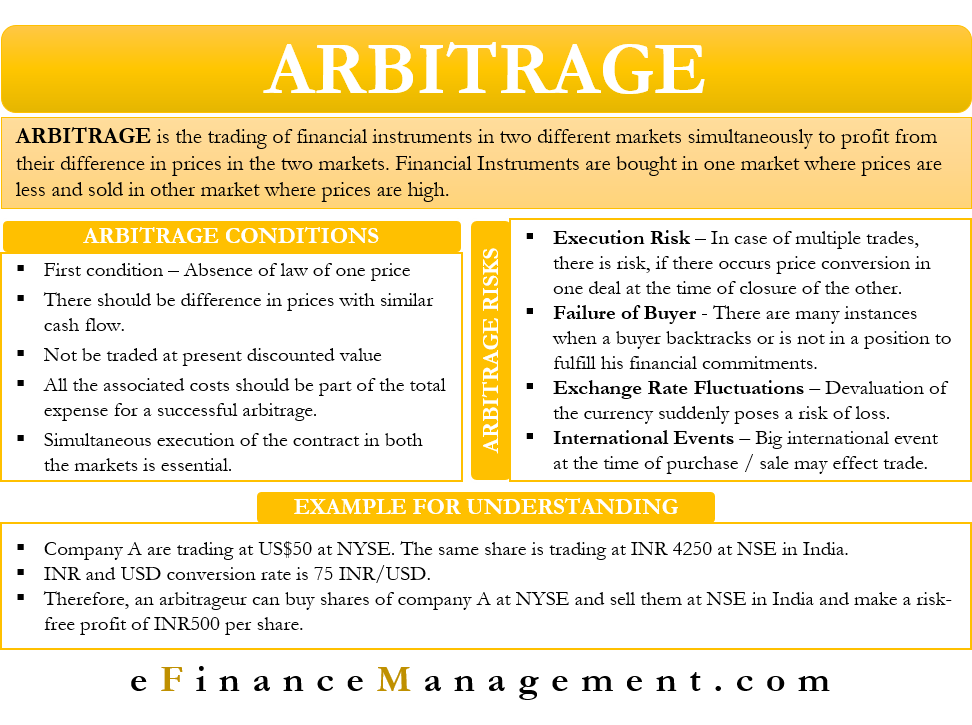Meaning of Arbitrage
Arbitrage is the trading of financial instruments in two different markets simultaneously to profit from their difference in prices in the two markets. These financial instruments may include shares, bonds, derivatives, currencies, and commodities. The idea is to earn profits by buying an instrument in one market where prices are lower and selling it in another market at a higher price. This difference or imbalance in prices of the same asset in different markets is generally due to market inefficiency. If there is no inefficiency, the prices in the two markets will converge, and there will be no arbitrage opportunity. Individuals, banks, or brokerage firms who adopt this strategy in trading are called Arbitrageurs.
Conditions for Arbitrage
- The first and foremost requirement for arbitrage is the absence of the law of one price. The asset should trade at different rates in different markets.
- There should be a difference in the prices of assets with similar cash flows.
- The asset should not trade at the present discounted value after considering the risk-free rate of interest.
- All types of Costs, such as storage and warehousing costs, transportation charges, transaction charges, etc., must be part of total expenses for a successful arbitrage. If these costs are high, the arbitrageur may end up incurring losses instead of profits when buying from one market and selling the asset in some other market.
- Simultaneous or almost simultaneous execution of trade in two markets is essential for a successful arbitrage. A time-lapse may prove costly, and the arbitrageur may incur losses due to price correction.
Examples
The purest form of arbitrage is buying and selling a share of a company on two cross-border stock exchanges at different rates. Suppose shares of Company A are trading at US$50 at NYSE. The same share is trading at INR 4250 at NSE in India. The current exchange rate of 1 USD is INR 75.
Therefore, an arbitrageur can buy shares of company A at NYSE and sell them at NSE in India and make a risk-free profit of INR500 per share. Even after considering the transaction costs associated with trading, the arbitrageur will end up making a good profit. He can continue to do the same and earn profits until there is a price correction of the share of company A on the two exchanges.
There can be similar arbitrage opportunities with the difference in exchange rates of different currencies. Taking further the above exchange rate, 1 USD= 75 INR. Suppose a person buys INR worth 1000 USD. He will have 75000 INR with him. Now let us say that 1 Euro= 80 INR. He converts the 75000 INR with him to 937.5 Euros (INR 75000/ 80).
The current exchange rate of 1 USD to Euros is 1.15. He will convert the 937.5 Euros with him to USD again. The converted amount will be roughly USD 1078 (937.5 Euros x 1.15). Thus, he will make a profit of USD 78 through arbitrage.
Also, read – Arbitrage Pricing Theory.

Risks in Arbitrage
Some of the risks involved in the strategy of arbitrage are:12
Execution Risk-
If an arbitrageur enters into multiple trades at a time, there is a high risk that while closing one position, there is a price convergence in his other deal, and his chances of making a profit are over. He may even incur a loss due to transaction charges.
Also, there is a high risk that there is no suitable buyer for his stock or commodity in the second market. It leads to the blockage of funds. If the deal is with borrowed funds, the interest charges may force him to go for a distress sale at lower prices than what he had purchased, leading to a loss.
Failure of the Buyer-
There are many instances when a buyer backtracks or is not in a position to fulfill his financial commitments. In such cases, an arbitrageur may incur substantial losses. For example, if he purchases commodity A from a market and the buyer in the second market backtracks and denies buying, he will get into serious trouble. If the prices of the commodity fall before selling, or the funds may remain blocked.
Exchange Rate Fluctuations-
In times of volatile global markets, the exchange rates of different currencies fluctuate constantly. An arbitrageur faces the risk of losses if there is a devaluation of the currency suddenly, where he has to sell the stock or instrument.
Any Important International Event-
In between the time of purchase and sale, if there is any big event that happens at the international level, which can impact the exchange rates or supply of that currency or commodity, etc., due to trade agreement or political situation. Then also, the buyer may run into losses.
Summary
Arbitrage offers excellent return opportunities if things go as planned. But hardly any investment house relies solely on this strategy. Electronic trading has left an almost negligible scope of difference in prices of stock across different exchanges worldwide.
Also, such investment strategies can be generally adopted by large financial institutions only as a lot of money is required to enter into such positions and execute them successfully. Also, the risk of losses is too high, which a small investor cannot undertake.
Nevertheless, arbitrage opportunities do exist across different markets worldwide. A mix of research, skills, and strategy can help an arbitrageur close a deal and earn profits successfully.
Continue reading – Currency Arbitrage.


Wow, this is an amazing platform, but how can I get started?
Because I don’t know how to start or get in.
Hey Kelly,
Welcome to eFinanceManagement.
For learning corporate finance, you can start following our menu/categories one by one from the home page.
We are soon coming up with an all-new design that will guide the learner better.